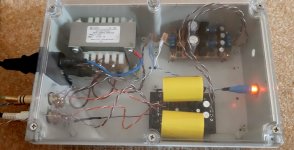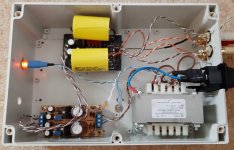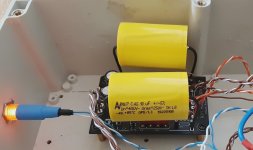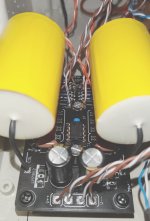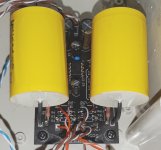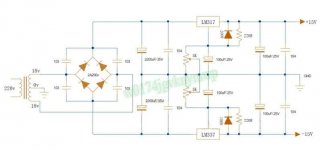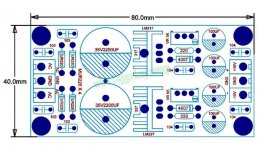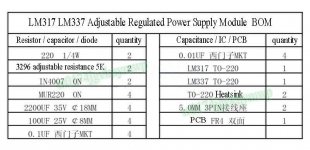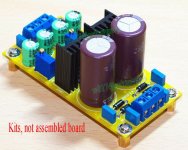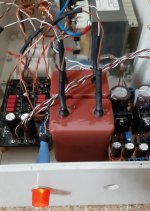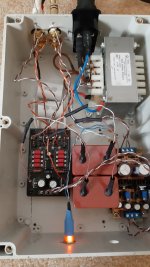Hello all,
I am sorry if this question has been answered already, but I would like to use a potentiometer to control and attenuate the levels audio levels from the VSPS kit.
This would be usefu because i often need to use it for recordings and some of my MM pickups are really high output, overloading the ADC chip on my recording device.
What is the recommended point for connecting a potentiometer? Also, what is the optimum value?
I am sorry if this question has been answered already, but I would like to use a potentiometer to control and attenuate the levels audio levels from the VSPS kit.
This would be usefu because i often need to use it for recordings and some of my MM pickups are really high output, overloading the ADC chip on my recording device.
What is the recommended point for connecting a potentiometer? Also, what is the optimum value?
This is a question which has come up a few times. There is no truly satisfactory answer, but the best option in general to control the output amplitude is to use feed the VSPS output through an active line preamplifier. Or use a recording device with adjustable input sensitivity.
If you are sure your MM pickups are not overloading the VSPS circuit itself, you can attenuate the output signal using a 10k potentiometer at the output. This will raise the output impedance significantly, however, so you want to put your recording device as close to the VSPS as possible, with minimal cable length.
If you are sure your MM pickups are not overloading the VSPS circuit itself, you can attenuate the output signal using a 10k potentiometer at the output. This will raise the output impedance significantly, however, so you want to put your recording device as close to the VSPS as possible, with minimal cable length.
Hey Richard
I'm in the process of building the stereo VSPS you sent me a couple weeks ago.
One thing I've been wondering about is in the power supply, why do you advise using 2 rectifier bridges? Couldn't we use the center tap of the toroid as the "com" and the two remaining leads as the ~ inputs on one bridge?
Im sure this was answered before but couldnt find an explanation. I really don't mind putting 2 of those bridges there (the ones from the BOM), I'm just curious.
Thanks,
I'm in the process of building the stereo VSPS you sent me a couple weeks ago.
One thing I've been wondering about is in the power supply, why do you advise using 2 rectifier bridges? Couldn't we use the center tap of the toroid as the "com" and the two remaining leads as the ~ inputs on one bridge?
Im sure this was answered before but couldnt find an explanation. I really don't mind putting 2 of those bridges there (the ones from the BOM), I'm just curious.
Thanks,
No, there is no reason you have to use two bridges. One is sufficient.
Two is just recommended since it's less likely to mess up the connection. (If your toroidal transformer has no center tap but two secondaries, there is ambiguity with respect to which wires you connect to make the center tap.)
Two is just recommended since it's less likely to mess up the connection. (If your toroidal transformer has no center tap but two secondaries, there is ambiguity with respect to which wires you connect to make the center tap.)
If your toroidal transformer has no center tap but two secondaries, there is ambiguity with respect to which wires you connect to make the center tap
That makes a lot of sense, thanks. I may have to go with the 1 rectifier approach out of space constrains, those medical 50vas are *big*. I doubt ditching 1 gives me a lot more space but its good to know I have the option.
Thanks again, Im eagerly waiting for my case to show up from China to continue this build.
Dear Richard,
Thanks for sending me the PCB board fast and without any issues!
I'll be populating the board during the weekend and posting my impressions.
However, I think I might need some help.
I have a few questions regarding the power supply:
1. The VPM24-1040 Triad transformer specified in the BOM, has inputs for both 220 & 240 VAC.
Our mains is actually 230 VAC over here so I was wondering, which of the inputs would be better to use?
The higher or the lower one?
2. The regulators specified are LM7812C/LM7912C.
Their spec-sheet states that they have a minimum required input voltage to maintain regulation of Vin=14.6V.
So my question is, how can they work with just 12V provided by the transformer?
3. Finally, I was wondering a similar thing as Leffler posted earlier.
If one would use a higher regulated voltage, i.e. 18V, would it have any undesirable effects on the RIAA correction circuit?
Still a novice in the process of learning, so please pardon me with all my questions.
Kind regards,
Nikos, Athens.
Thanks for sending me the PCB board fast and without any issues!
I'll be populating the board during the weekend and posting my impressions.
However, I think I might need some help.
I have a few questions regarding the power supply:
1. The VPM24-1040 Triad transformer specified in the BOM, has inputs for both 220 & 240 VAC.
Our mains is actually 230 VAC over here so I was wondering, which of the inputs would be better to use?
The higher or the lower one?
2. The regulators specified are LM7812C/LM7912C.
Their spec-sheet states that they have a minimum required input voltage to maintain regulation of Vin=14.6V.
So my question is, how can they work with just 12V provided by the transformer?
3. Finally, I was wondering a similar thing as Leffler posted earlier.
If one would use a higher regulated voltage, i.e. 18V, would it have any undesirable effects on the RIAA correction circuit?
Still a novice in the process of learning, so please pardon me with all my questions.
Kind regards,
Nikos, Athens.
Last edited:
1. The VPM24-1040 Triad transformer specified in the BOM, has inputs for both 220 & 240 VAC.
Our mains is actually 230 VAC over here so I was wondering, which of the inputs would be better to use?
The higher or the lower one?
Both are workable, choose which one depending if you want a little bit higher or a little bit lower secondary voltage. I would suggest using 240 V windings, so the output secondary will be a little low, counteracting the natural tendency of the transformer output to be higher when lightly loaded.
2. The regulators specified are LM7812C/LM7912C.
Their spec-sheet states that they have a minimum required input voltage to maintain regulation of Vin=14.6V.
So my question is, how can they work with just 12V provided by the transformer?
12 V is 12 V AC. After the diodes and after the action of the filter capacitors, this becomes about 1.4x larger, or 17 V DC.
3. Finally, I was wondering a similar thing as Leffler posted earlier.
If one would use a higher regulated voltage, i.e. 18V, would it have any undesirable effects on the RIAA correction circuit?
The RIAA network is not voltage dependent, so you can run the op amps at any voltage they are designed for. But you must respect the headroom needed for the regulator. So if you are using LM7812 for 12 V output, the input should be about 17 V, if you are using LM7818 for 18 V output, the input should be 23 V. Or you can remove the on-board regulators and use your own regulated supply. In that case it's the regulated output that matters, and it can be any value from 8-9 V to 18 V.
regards,
Richard
Richard,
Thanks a lot for the help already.
Really appreciate your promt replies.
Could you also define the actual input capacitance seen by the cartridge?
My assumption would be that it's very low or even zero without any additional 'loading' capacitors, but I could be wrong.
Thanks in advance.
Best Regards,
Nikos, Athens.
Thanks a lot for the help already.
Really appreciate your promt replies.
Could you also define the actual input capacitance seen by the cartridge?
My assumption would be that it's very low or even zero without any additional 'loading' capacitors, but I could be wrong.
Thanks in advance.
Best Regards,
Nikos, Athens.
The cartridge sees the capacitance of the phono cable. That's the biggest contribution unless you expressly add capacitance. A shielded phono cable will typically be 100 pF/m.
I found some time to complete the VSPS project and I am evaluating it right now. Here are some pictures of the board, together with the transformer and power supply in its box:






I've used socket pins in place of the input loading resistor and the series resistors after the opamp (using an OPA2134). It is convenient for changing parts for testing.
Also, I've used Vishay Dale resistors (CMF/RN series) instead of the KOA Speer on the BOM, since the price difference was pretty small.
I have installed all metal films but the Kamaya carbon composition is here waiting to be tested against those Dale metal films.
Will repost back on that.
For the output capacitors, right now I installed a pair of Kemet 10uF polypropylene metallized film (mouser no. 80-C4GAFUD5100AA1J). I also have a Cornell Dubilier 3.3uF pair (mouser no. 598-936C4W3P3K-F) and a few Russian PIO pairs to be tested on that position. Will report on them as well.
I am still in the process of breaking it in but my preliminary impressions with it are very positive.
I like the fact that this is a simple circuit with less stuff to worry about.
The sound I get from it is already superior to my other phono stages (against some of my integrated amplifiers/AVRs and a 2x12AX7 tube kit i've built lately).
It has a very good soundstage, that is both wide and deep.
Especially enjoying the additional layers of depth with it.
Separation of instruments is also better nd the whole sonic image feel more expansive which is always a good thing.
In terms of transients, it feels fluid and plays along effortlessly, with a very neutral tonality to my ears.
Without any IC harshness or any audible noise whatsoever.
It is dead silent, even when the unshielded input/output twisted wires are running so close to the transformer.
Nicely done Richard!
Thanks for reading and of course any recommendations from anyone would be welcome.
I've used socket pins in place of the input loading resistor and the series resistors after the opamp (using an OPA2134). It is convenient for changing parts for testing.
Also, I've used Vishay Dale resistors (CMF/RN series) instead of the KOA Speer on the BOM, since the price difference was pretty small.
I have installed all metal films but the Kamaya carbon composition is here waiting to be tested against those Dale metal films.
Will repost back on that.
For the output capacitors, right now I installed a pair of Kemet 10uF polypropylene metallized film (mouser no. 80-C4GAFUD5100AA1J). I also have a Cornell Dubilier 3.3uF pair (mouser no. 598-936C4W3P3K-F) and a few Russian PIO pairs to be tested on that position. Will report on them as well.
I am still in the process of breaking it in but my preliminary impressions with it are very positive.
I like the fact that this is a simple circuit with less stuff to worry about.
The sound I get from it is already superior to my other phono stages (against some of my integrated amplifiers/AVRs and a 2x12AX7 tube kit i've built lately).
It has a very good soundstage, that is both wide and deep.
Especially enjoying the additional layers of depth with it.
Separation of instruments is also better nd the whole sonic image feel more expansive which is always a good thing.
In terms of transients, it feels fluid and plays along effortlessly, with a very neutral tonality to my ears.
Without any IC harshness or any audible noise whatsoever.
It is dead silent, even when the unshielded input/output twisted wires are running so close to the transformer.
Nicely done Richard!
Thanks for reading and of course any recommendations from anyone would be welcome.
Attachments
Last edited:
A few updates on my ongoing evaluation.
As I said, I'm positively impressed with the performance of VSPS.
However, contrary to my initial impressions, the 2x12AX7 phono stage might in fact have a slight sonic advantage over the VSPS with most of my 60s music (blues, jazz, soul etc).
Tubes seem to have the edge in terms of soundstage, pace/flow and decay and retain a slightly warmer tonality which I personally like.
Of course, a different combination of opamp and parts in the VSPS might change all that.
Now, regarding the Russian PIO 10μF capacitors, they do offer a sonic improvement over the Kemet 10μF metallised polypropylene film ones.
And the Kamaya 47Ω carbon composition resistors (in series after the opamp) offer a sonic improvement over the Dale metal film ones.
Basically, with both the PIO caps and the Kamaya carbon comps, I got very close to the desirable qualities of the tube phono pre, without suffering any degradations.
I want to stress that the aforementioned differences are all very small in practice.
I use recordings of the same source that are gain adjusted within 0.3dB.
Then I compare them by listening on my Sennheiser HD599 pair, through my Lehmann Linear clone amp.
I audition them by using the on-the-fly ABX comparator plugin on foobar2000.
Otherwise I'd probably be incapable of identifying any differences.
I'll keep you updated!
As I said, I'm positively impressed with the performance of VSPS.
However, contrary to my initial impressions, the 2x12AX7 phono stage might in fact have a slight sonic advantage over the VSPS with most of my 60s music (blues, jazz, soul etc).
Tubes seem to have the edge in terms of soundstage, pace/flow and decay and retain a slightly warmer tonality which I personally like.
Of course, a different combination of opamp and parts in the VSPS might change all that.
Now, regarding the Russian PIO 10μF capacitors, they do offer a sonic improvement over the Kemet 10μF metallised polypropylene film ones.
And the Kamaya 47Ω carbon composition resistors (in series after the opamp) offer a sonic improvement over the Dale metal film ones.
Basically, with both the PIO caps and the Kamaya carbon comps, I got very close to the desirable qualities of the tube phono pre, without suffering any degradations.
I want to stress that the aforementioned differences are all very small in practice.
I use recordings of the same source that are gain adjusted within 0.3dB.
Then I compare them by listening on my Sennheiser HD599 pair, through my Lehmann Linear clone amp.
I audition them by using the on-the-fly ABX comparator plugin on foobar2000.
Otherwise I'd probably be incapable of identifying any differences.
I'll keep you updated!
Last edited:
Hey evonimos,
What are you using for a power supply, and what is the voltage output?
You don't actually need regulated power supply like that, the regulators on the VSPS will be enough, just connect the VSPS directly to the diode rectifier.
Richard
What are you using for a power supply, and what is the voltage output?
You don't actually need regulated power supply like that, the regulators on the VSPS will be enough, just connect the VSPS directly to the diode rectifier.
Richard
Hello Richard,Hey evonimos,
What are you using for a power supply, and what is the voltage output?
You don't actually need regulated power supply like that, the regulators on the VSPS will be enough, just connect the VSPS directly to the diode rectifier.
Richard
I 'm using this 'el-cheapo' LM317/337 adjustable, dual power supply, I had available:
I didn't have any LM7x12 regulators at hand, so I tried this kit and seems to work just fine. I have it adjusted @2x15V right now.
Do you think it is a problem?
Attachments
Oh, I see - you haven't installed the regs on the VSPS board. In that case, sure, that power supply will do the trick and you can run it at 15 V, the op amp won't mind.
So I did some more auditioning and testing and I ended up having the Russian PIO capacitors in parallel with a pair of 3.3uF Cornell Dubilier Type 936 (mouser no. 598-936C4W3P3K-F).


This combination further improved things, adding a bit more speed and layering to the sound.
With this combination of parts, I think the VSPS have now surpassed the performance of my tube phono preamp.
If I want further improvements, I might try some different parallel capacitors or even exchange some resistors for carbon composition ones.
I was impressed at how nice they sound compared to the usual CMF/RN series metal films. Now, I can see that Richard has included them in the BOM for a reason.
This combination further improved things, adding a bit more speed and layering to the sound.
With this combination of parts, I think the VSPS have now surpassed the performance of my tube phono preamp.
If I want further improvements, I might try some different parallel capacitors or even exchange some resistors for carbon composition ones.
I was impressed at how nice they sound compared to the usual CMF/RN series metal films. Now, I can see that Richard has included them in the BOM for a reason.
Attachments
Evonimos, no hum with the power transformer in the same case?
No audible hum whatsoever.
For even better results I could use a toroidal transformer, away from the signal parts, but that was what I had available at the moment.
I could see some minor interference at idle (no signal), while I was recording in Audacity and the remedy was simple.
I had to move the wires a bit and route them a bit further away from the transformer. You can see them last pictures I have attached.
These are unshielded twisted pairs as you can see and are not the prettiest things but they work fine.
If I'd use a properly shielded coaxial cable for the input/output it would totally negate any possible interference.
But I've decided decided to go with unshielded, twisted pair, single core copper wires because I've found them to improve the sound a tiny bit.
A quick update on my on-going auditioning tests:
I reverted back to using only the Russian PIO 10uF capacitors.
While impressive at first, the paralleled Cornell Dubilier polypropylene capacitors, actually made the sound a bit less focused overall. They added a tube-like effect on the audio image that can be enticing, but after some more listening I found out that I prefer the comparatively 'austere' and cleaner presentation of just using the Russian PIOs.
A similar thing was observed between the Dale CMF series and the Kamaya carbon composition resistors.
After re-evaluating the metal films I realised that the carbon composition have a property of adding a layer of pleasant and 'soothing' distortion to the sound. Again. not unlike tubes in that sense.
That resulting effect of the carbons was particularly enticing to me since I was coming from a tube preamp.
They do sound more mellow and 'expanded' and that can make them both impressive and enjoyable.
However, I am back to the metal films at the moment.
I thought I should try something different and less 'tubey' for a while.
And to be honest I actually enjoy that sort of change. At least for the time being.
I like that small improvement in details they offer, compared to the somewhat less focused carbons.
Being more 'accurate' I guess, helps in creating a better imagining and overall sense of speed which is nice.
So for now I'll keep the metal film ones on, but both options are available for the future.
The option of switching between the two is the really nice, depending on mood and type of music.
Next ones to try out will be some different carbon composition ones plus some carbon films.
I'll report back.
I reverted back to using only the Russian PIO 10uF capacitors.
While impressive at first, the paralleled Cornell Dubilier polypropylene capacitors, actually made the sound a bit less focused overall. They added a tube-like effect on the audio image that can be enticing, but after some more listening I found out that I prefer the comparatively 'austere' and cleaner presentation of just using the Russian PIOs.
A similar thing was observed between the Dale CMF series and the Kamaya carbon composition resistors.
After re-evaluating the metal films I realised that the carbon composition have a property of adding a layer of pleasant and 'soothing' distortion to the sound. Again. not unlike tubes in that sense.
That resulting effect of the carbons was particularly enticing to me since I was coming from a tube preamp.
They do sound more mellow and 'expanded' and that can make them both impressive and enjoyable.
However, I am back to the metal films at the moment.
I thought I should try something different and less 'tubey' for a while.
And to be honest I actually enjoy that sort of change. At least for the time being.
I like that small improvement in details they offer, compared to the somewhat less focused carbons.
Being more 'accurate' I guess, helps in creating a better imagining and overall sense of speed which is nice.
So for now I'll keep the metal film ones on, but both options are available for the future.
The option of switching between the two is the really nice, depending on mood and type of music.
Next ones to try out will be some different carbon composition ones plus some carbon films.
I'll report back.
Last edited:
- Home
- Source & Line
- Analogue Source
- The Phonoclone and VSPS PCB Help Desk

